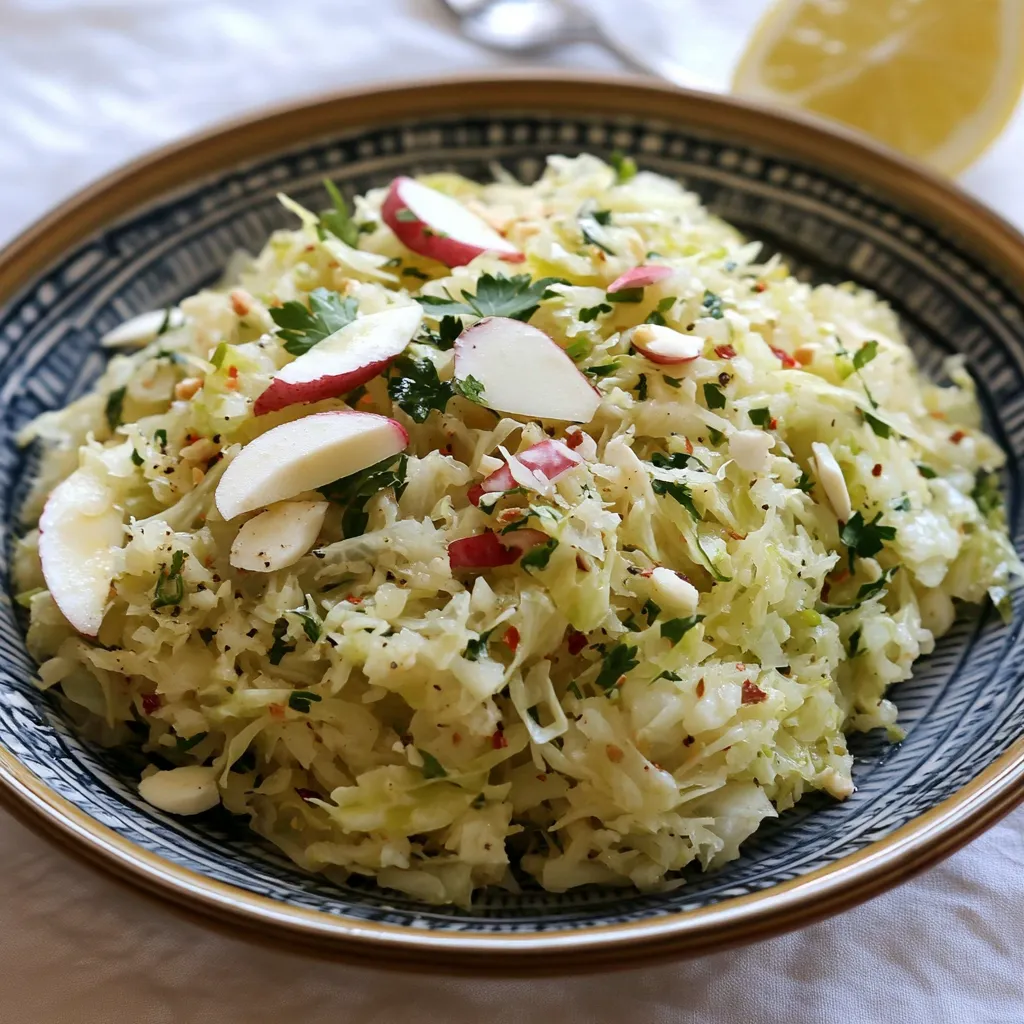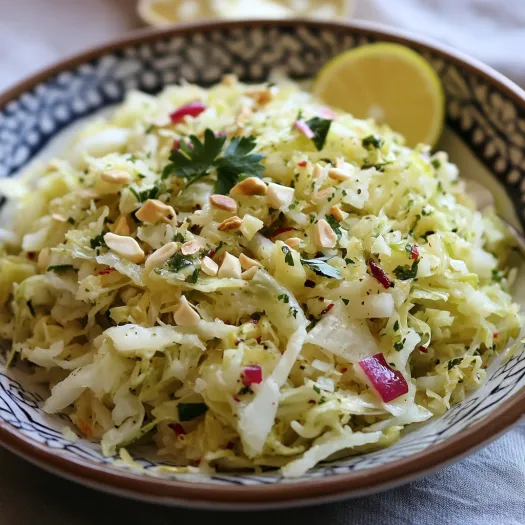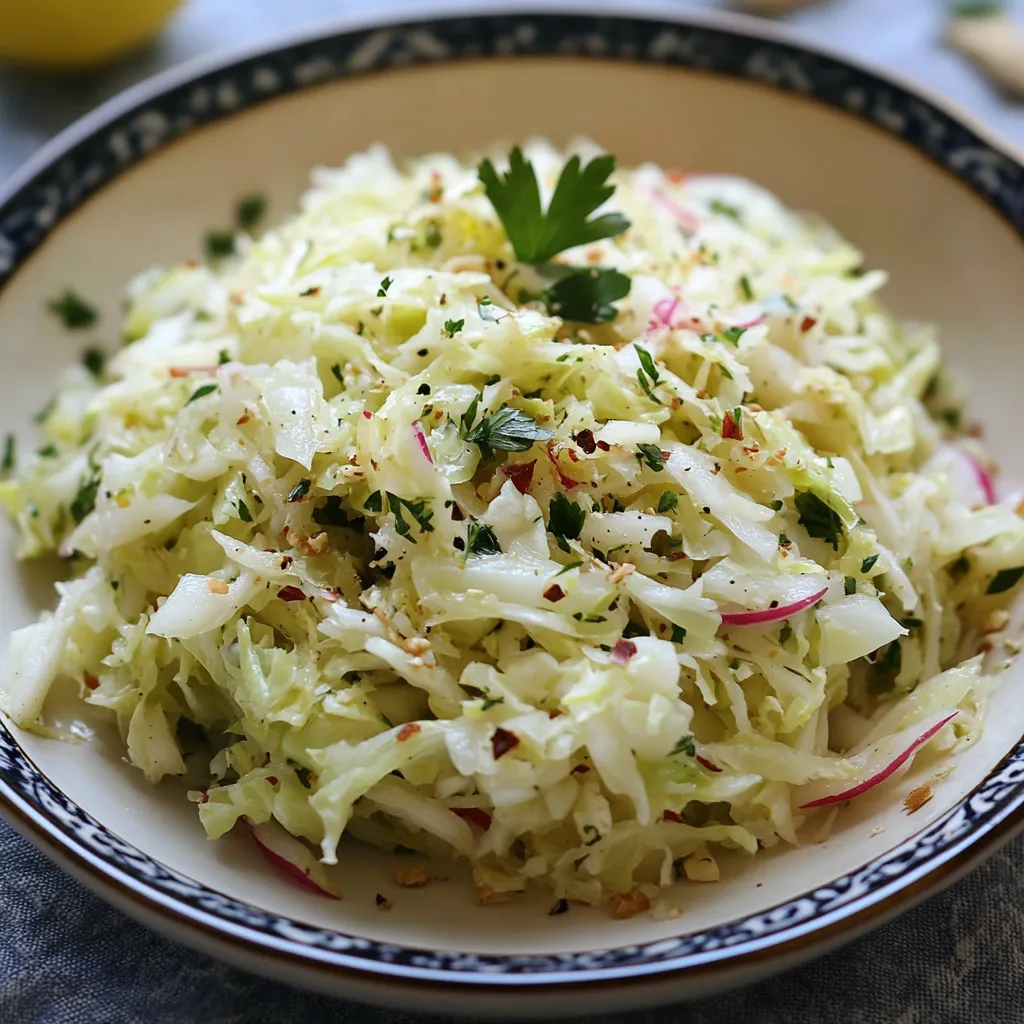 Pin it
Pin it
This traditional Lebanese Malfouf Salad brings together the perfect balance of crisp vegetables and zesty dressing for a refreshing side dish that complements any Middle Eastern feast. The simple preparation lets the fresh ingredients shine while delivering an explosion of flavor that will transport you straight to a Lebanese family table.
I discovered this recipe while traveling through Lebanon years ago when a local grandmother invited me into her kitchen. The way her family gathered around this humble cabbage salad showed me how the simplest dishes often create the most meaningful connections.
Ingredients
- Savoy Cabbage: creates the tender base of this salad with its delicate texture that absorbs flavors beautifully while maintaining crispness
- Scallions: provide a mild oniony flavor that adds dimension without overpowering the other ingredients
- Flat Leaf Parsley: brings freshness and a slightly peppery note essential to authentic Lebanese flavor
- Mint leaves: contribute a cooling sensation that balances the garlic and lemon perfectly
- Radishes: add a peppery crunch and beautiful color contrast look for firm radishes with bright red skin
- Lemon Juice: for both the salad base and dressing its acidity helps tenderize the cabbage slightly
- Garlic: use fresh firm cloves without any green sprouts for the cleanest flavor
- Olive Oil: select a good quality extra virgin variety for the best flavor profile
- Lemon Zest: contains the aromatic oils that intensify the citrus notes
- Honey: just a touch balances the acidity without making the dressing sweet
Step-by-Step Instructions
- Prep The Cabbage:
- Begin with proper cabbage preparation which is crucial for texture. Using a sharp serrated knife cut directly through the center of the cabbage. Work methodically shredding only the tender leaves and discarding tougher sections near the core. The thin shreds should separate easily when you loosen them with your fingers creating the light texture this salad is known for.
- Create The Base Mixture:
- Combine your shredded cabbage with the sliced scallions herbs and radishes in a large bowl. The initial lemon juice bath serves two purposes it begins to soften the cabbage ever so slightly and prevents oxidation keeping everything bright and fresh. Toss everything gently to ensure even distribution.
- Master The Toum Inspired Dressing:
- This step transforms the salad. The garlic paste technique creates a dressing similar to Lebanese toum but lighter. Blending garlic with salt creates a smooth base while slowly incorporating lemon juice and olive oil emulsifies the mixture into a creamy consistency. The key is adding oil in a very slow stream while the processor runs continuously. Patience here results in a light airy dressing that clings perfectly to each cabbage shred.
- Final Assembly:
- Drizzle the prepared dressing over the vegetable mixture starting with less than you think you need. Toss gently using your hands is traditional to prevent bruising the delicate ingredients. The salad should be lightly coated not drowning in dressing. Serve immediately for maximum crispness and flavor.
 Pin it
Pin it
The most magical element in this recipe is undoubtedly the garlic dressing. My Lebanese friend Amal showed me the proper blending technique that transforms ordinary ingredients into something extraordinary. When her grandmother tasted my first attempt she nodded approvingly which remains one of my proudest culinary moments.
Traditional Context
Malfouf salad has deep roots in Lebanese home cooking where cabbage is celebrated for both its affordability and nutritional benefits. Historically this dish appeared on tables during times of celebration and everyday meals alike. The name "malfouf" actually means "rolled" in Arabic referring to the cabbage leaves typically used for stuffing. This salad repurposes the same vegetable in its raw form demonstrating the resourcefulness of Lebanese cuisine.
Storage Tips
This salad maintains its best texture when eaten fresh but can be stored for up to 24 hours. If planning ahead prepare all components separately keeping the dressing in an airtight container and vegetables in another. Combine just before serving for optimal crispness. The dressing alone will keep refrigerated for up to five days becoming even more flavorful as the garlic mellows.
Serving Suggestions
Malfouf salad traditionally appears alongside grilled meats particularly lamb or beef kebabs. The bright acidity cuts through rich fatty flavors beautifully. For a complete vegetarian meal pair with falafel warm pita hummus and baba ganoush. During summer months serve alongside grilled halloumi cheese for a light yet satisfying meal that requires minimal cooking.
Seasonal Adaptations
While traditionally made with cabbage this salad welcomes seasonal adaptations. In spring add fava beans for added protein. Summer versions can include diced cucumber for extra freshness. Fall variations work beautifully with the addition of pomegranate seeds which add both color and sweet tartness. Winter adaptations might include shredded carrots for added sweetness and color.
 Pin it
Pin it
Frequently Asked Questions
- → What makes this salad uniquely Lebanese?
Its use of fresh parsley, mint, and a zesty lemon-garlic dressing reflects traditional Lebanese flavor profiles.
- → Can I use a different type of cabbage?
Yes, you can substitute Savoy cabbage with green or Napa cabbage, though texture and taste may vary slightly.
- → How do I prevent the cabbage from becoming soggy?
Ensure the cabbage is shredded finely but handled gently to maintain a crisp texture. Toss with dressing right before serving.
- → Can the dressing be made ahead of time?
Yes, prepare the dressing up to a day in advance and store it in the refrigerator. Whisk it again before serving.
- → Is this salad suitable for vegan diets?
Yes, this Lebanese cabbage salad is entirely vegan, made with fresh vegetables, herbs, and plant-based ingredients.
- → Can I make this salad spicy?
For a spicy kick, add finely sliced chili peppers or a sprinkle of red chili flakes to the salad.
